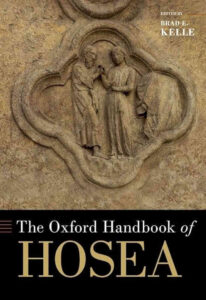KELLE, B. E. (ed.) The Oxford Handbook of Hosea. New York: Oxford University Press, 2024, 520 p. – ISBN 9780197639597.
Esta é uma coleção de ensaios com múltiplos recursos para a interpretação do livro de Oseias. O volume examina abordagens que são consideradas essenciais para a interpretação ou que são representativas das tendências atuais na pesquisa do livro de Oseias.
interpretação ou que são representativas das tendências atuais na pesquisa do livro de Oseias.
Cada ensaio aborda um elemento em particular e faz um levantamento crítico de estudos anteriores antes de apresentar abordagens atuais e prospectivas.
De muitas maneiras a pesquisa sobre o livro de Oseias é representativa dos desenvolvimentos e tendências atuais no estudo do profetismo como um todo. Portanto, embora dedicada ao livro de Oseias, a coleção de ensaios neste volume fornece um instantâneo de como deve ser a pesquisa atual sobre um livro profético.
A coleção começa com ensaios orientados para o contexto discutindo a história, o texto e o crescimento composicional de Oseias.
O volume inclui uma seção de ensaios sobre perspectivas estabelecidas e emergentes sobre os principais textos representativos do livro.
Em seguida os ensaios tratam dos principais elementos teológicos e literários, temas e motivos do livro de Oseias, antes de prosseguir para examinar diversas teorias interpretativas, contextos e abordagens.
O último grupo de ensaios no volume investiga as principais tendências na história da recepção de Oseias, incluindo o uso do livro em filmes e romances populares, bem como a interpretação asiática e afro-americana.
Brad E. Kelle é Professor de Antigo Testamento e Hebraico Bíblico na Point Loma Nazarene University, San Diego, California.
The Oxford Handbook of Hosea is a collection of essays that provide resources for the interpretation of the book of Hosea. The volume examines interpretive elements and approaches that are deemed essential for interpretation or that are representative of significant trends in present and future study. Each essay addresses one particular element or approach and will critically survey prior scholarship before presenting current and prospective approaches.
In many ways, research on the book of Hosea is representative of the developments and current trends in prophetic study as a whole. Hence, while dedicated to the book of Hosea, the collection of essays in this volume provides a snapshot of what today’s fully orbed scholarship on a prophetic book should look like. The collection begins with background-oriented essays that discuss the history, text, and compositional growth of Hosea. The volume includes a section of essays that survey established and emerging perspectives on key representative texts from the book. The essays then treat the book of Hosea’s major theological and literary elements, themes, and motifs before moving on to examine diverse interpretive theories, contexts, and approaches. The final group of essays in the volume investigates major trends in the reception history of Hosea, including the book’s use in popular movies and novels, as well as Asian and African American interpretation.
Table of Contents
List of Abbreviations
About the Contributors
Acknowledgments
Introduction, Brad E. Kelle
1. Does (and Should) Hosea Matter Still?, Carol J. Dempsey, OP
Part I: History, Text, and Composition
2. The Book of Hosea and the History of Eighth-Century BCE Israel, Shuichi Hasegawa
3. Assyria and Its Image in Hosea, Shawn Zelig Aster
4. Hosea the “Historical Prophet” of the Eighth Century BCE, Hosea the Remembered Prophet of Yehudite Literati, and the Book of Hosea, Ehud Ben Zvi and Ian D. Wilson
5. The Book of Hosea and Israelite Religion in the Eighth Century BCE, Lena-Sofia Tiemeyer
6. The Book of Hosea and the Socioeconomic Conditions of Eighth-Century BCE Israel, Davis Hankins
7. Transformation and Reinterpretation in the Composition and Redaction of Hosea, Susanne Rudnig-Zelt
8. The Book of Hosea and Northern/Israelian Hebrew, Na’ama Pat-El
9. Texts and Versions of the Book of Hosea, Eric J. Tully
10. Hosea in the Book of the Twelve, Mark Leuchter
Part II: Key Texts: Established and Emerging Perspectives
11. Hosea 1-3, the Marriage Metaphor, and the Ties that Bind, Amy Kalmanofsky
12. Hosea 5:8-6:6, Alt’s Hypothesis, and New Possibilities, Marvin A. Sweeney
13. Hosea 7-8 and the Critique of Kings, Politics, and Power, Jerry Hwang
14. Hosea 11 and Metaphors of Identity, Relationship, and Core Values in Contexts of Trauma, Jennifer M. Matheny
15. Hosea 12-13 and Prophetic Composition, Rhetoric, and Recollection, John Goldingay
Part III: Theological and Literary Elements, Themes, and Motifs
16. Metaphors in the Book of Hosea, Mason D. Lancaster
17. Intertextuality and Traditions in the Book of Hosea, Göran Eidevall
18. God’s Character in the Book of Hosea, Bo H. Lim
19. Kingship and Political Power in the Book of Hosea, Heath D. Dewrell
20. Sin and Punishment in the Book of Hosea, Joshua N. Moon
21. Repentance in the Book of Hosea, Mark J. Boda
22. Gender and Sexual Violence in Hosea, Kirsi Cobb
Part IV: Interpretive Theories and Approaches
23. Hosea in Feminist and Womanist Interpretation, Vanessa Lovelace
24. Masculinity Studies and Hosea, Susan E. Haddox
25. Queer Theory and Hosea, Jennifer J. Williams
26. Postcolonialism as a Methodological Approach to Hosea, Jeremiah W. Cataldo
27. Prolegomena to the Ecological Interpretation of Hosea, Peter Trudinger
Part V: Reception
28. Hosea in Rabbinic Literature, Devorah Schoenfeld
29. Hosea in the New Testament, Steve Moyise
30. Hosea in Popular Culture, Emily O. Gravett
31. The Ghost of Hosea in African American Interpretation, Aaron Dorsey
32. Hosea in Asia-centric Interpretation, Barbara M. Leung Lai
Index
Brad E. Kelle is Professor of Old Testament and Hebrew at Point Loma Nazarene University in San Diego, CA.